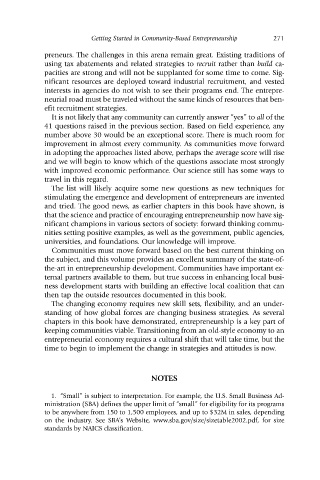Page 282 - 1-Entrepreneurship and Local Economic Development by Norman Walzer (z-lib.org)
P. 282
Getting Started in Community-Based Entrepreneurship 271
preneurs. The challenges in this arena remain great. Existing traditions of
using tax abatements and related strategies to recruit rather than build ca-
pacities are strong and will not be supplanted for some time to come. Sig-
nificant resources are deployed toward industrial recruitment, and vested
interests in agencies do not wish to see their programs end. The entrepre-
neurial road must be traveled without the same kinds of resources that ben-
efit recruitment strategies.
It is not likely that any community can currently answer “yes” to all of the
41 questions raised in the previous section. Based on field experience, any
number above 30 would be an exceptional score. There is much room for
improvement in almost every community. As communities move forward
in adopting the approaches listed above, perhaps the average score will rise
and we will begin to know which of the questions associate most strongly
with improved economic performance. Our science still has some ways to
travel in this regard.
The list will likely acquire some new questions as new techniques for
stimulating the emergence and development of entrepreneurs are invented
and tried. The good news, as earlier chapters in this book have shown, is
that the science and practice of encouraging entrepreneurship now have sig-
nificant champions in various sectors of society: forward thinking commu-
nities setting positive examples, as well as the government, public agencies,
universities, and foundations. Our knowledge will improve.
Communities must move forward based on the best current thinking on
the subject, and this volume provides an excellent summary of the state-of-
the-art in entrepreneurship development. Communities have important ex-
ternal partners available to them, but true success in enhancing local busi-
ness development starts with building an effective local coalition that can
then tap the outside resources documented in this book.
The changing economy requires new skill sets, flexibility, and an under-
standing of how global forces are changing business strategies. As several
chapters in this book have demonstrated, entrepreneurship is a key part of
keeping communities viable. Transitioning from an old-style economy to an
entrepreneurial economy requires a cultural shift that will take time, but the
time to begin to implement the change in strategies and attitudes is now.
NOTES
1. “Small” is subject to interpretation. For example, the U.S. Small Business Ad-
ministration (SBA) defines the upper limit of “small” for eligibility for its programs
to be anywhere from 150 to 1,500 employees, and up to $32M in sales, depending
on the industry. See SBA’s Website, www.sba.gov/size/sizetable2002.pdf, for size
standards by NAICS classification.

